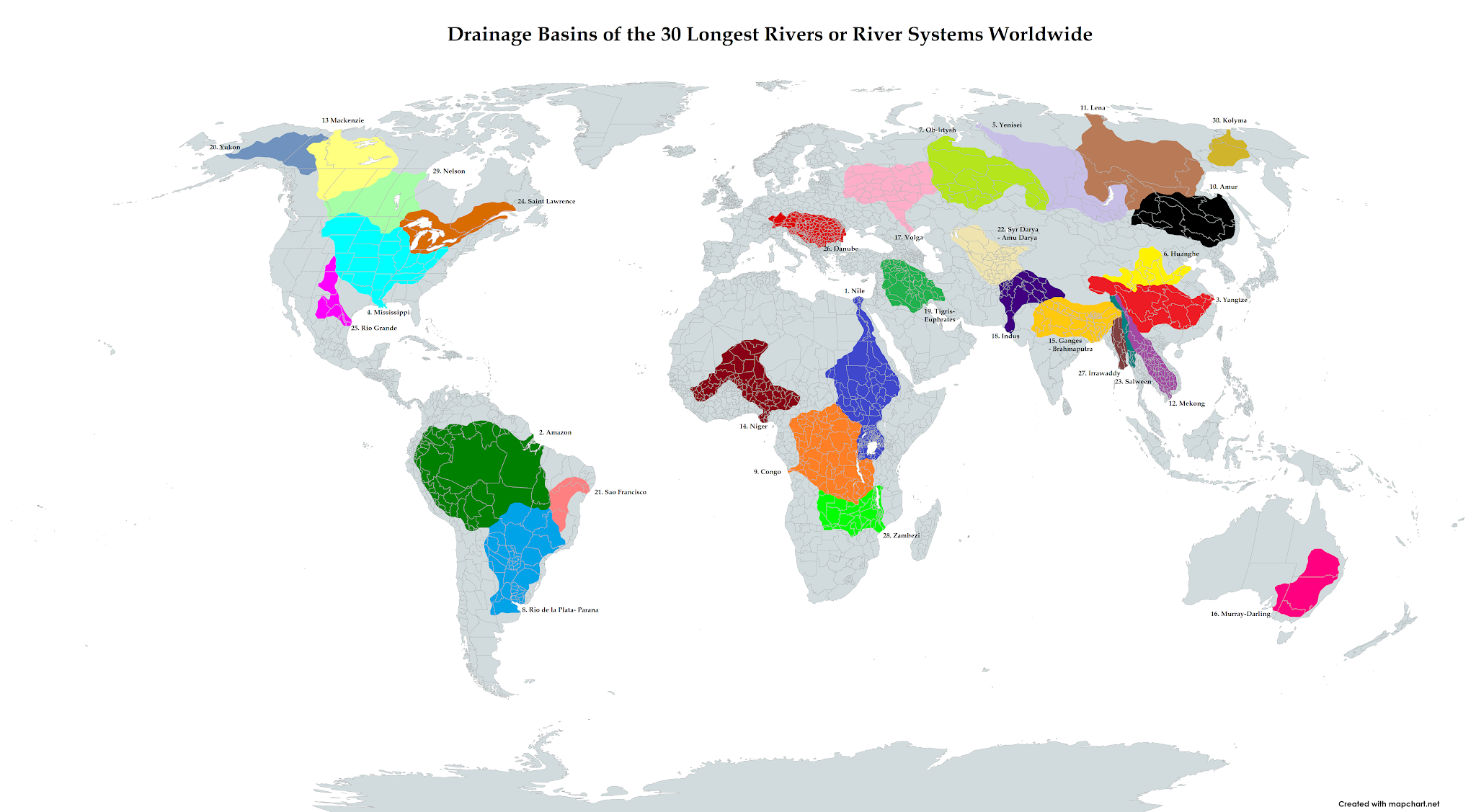Most of our Earth’s surface is coated in water, but only less than one percent of it is freshwater. The total water volume in rivers is measured at 2,120 cu km (510 cu mi), or only 0.49 percent of the surface fresh water on the planet!
But notwithstanding this fact, rivers have played and still play an essential role in civilization progress.
Rivers are the result of numerous compounding water inflows gained within a drainage basin. A drainage basin is defined as the land area where precipitation collects and drains off, feeding rivers and their tributaries.
The map below created by Reddit user CountZapolai shows how large the drainage basins can be for the world’s longest rivers.
The longer a river system becomes, the more territory it passes through. As a result, long rivers have extensive drainage basins.
The Amazon river has the most extensive basin system worldwide, covering one-third of the whole continent of South America. The 10 longest rivers of the Earth covering a land area equivalent to Africa.
Top 30 the longest rivers in the world and the size of their drainage basins, Length in km (miles) / Drainage area in km2 (mi2)
1. Nile - 6,650 (4,130) / 3,254,555 (1,256,585)
2. Amazon - 6,400 (3,976) / 7,000,000 (2,702,703)
3. Yangtze - 6,300 (3,917) / 1,800,000 (694,981)
4. Mississippi - 6,275 (3,902) / 2,980,000 (1,150,579)
5. Yenisei - 5,539 (3,445) / 2,580,000 (996,139)
6. Yellow River - 5,464 (3,395) / 745,000 (287,645)
7. Ob–Irtysh - 5,410 (3,364) / 2,990,000 (1,154,440)
8. Río de la Plata - 4,880 (3,364) / 2,582,672 (997,171)
9. Congo - 4,700 (2,922) / 3,680,000 (1,420,849)
10. Amur - 4,444 (2,763) / 1,855,000 (716,216)
11. Lena - 4,400 (2,736) / 2,490,000 (961,390)
12. Mekong - 4,350 (2,705) / 810,000 (312,741)
13. Mackenzie - 4,241 (2,637) / 1,790,000 (691,120)
14. Niger - 4,200 (2,611) / 2,090,000 (806,950)
15. Brahmaputra-Ganga - 3,969 (2,466) / 1,320,000 (509,655)
16. Murray - 3,672 (2,282) / 1,061,000 (409,653)
17. Tocantins - 3,650 (2,270) / 950,000 (366,795)
18. Volga - 3,645 (2,266) / 1,380,000 (532,819)
19. Indus - 3,610 (2,250) / 960,000 (370,656)
20. Euphrates - 3,596 (2,236) / 884,000 (341,313)
21. Yukon - 3,185 (1,980) / 328187 (328,187)
22. São Francisco - 3,180 (1,976) / 610,000 (235,521)
23. Syr Darya - 3,078 (1,913) / 219,000 (84,556)
24. Salween - 3,060 (1,901) / 324,000 (125,097)
25. Saint Lawrence - 3,058 (1,900) / 1,030,000 (397,683)
26. Rio Grande - 3,057 (1,900) / 570,000 (220,077)
27. Danube - 2,888 (1,795) / 817,000 (315,444)
28. Irrawaddy - 2,809 (1,745) / 404,200 (156,062)
29. Zambezi - 2,740 (1,703) / 1,330,000 (513,516)
30. Amu Darya - 2,620 (1,628) / 534,739 (206,464)

This post may contain affiliate links. As an Amazon Associate, I earn from qualifying purchases.
Comments
Post a Comment